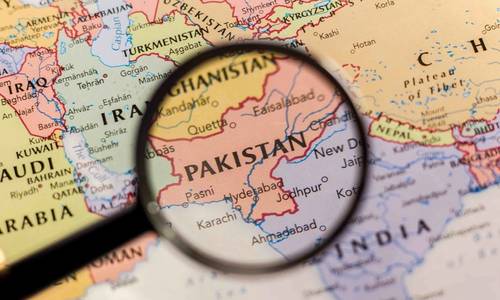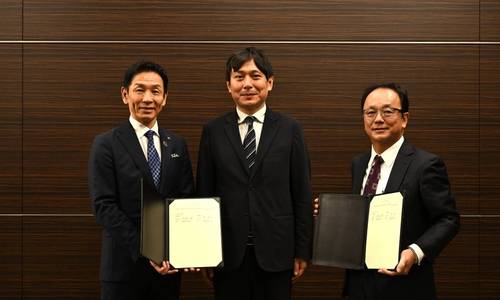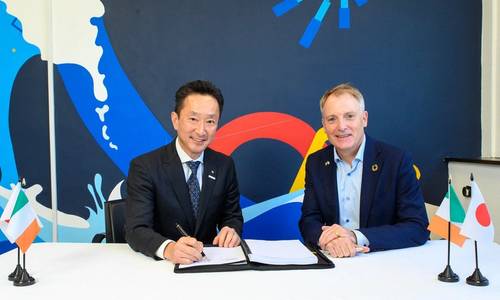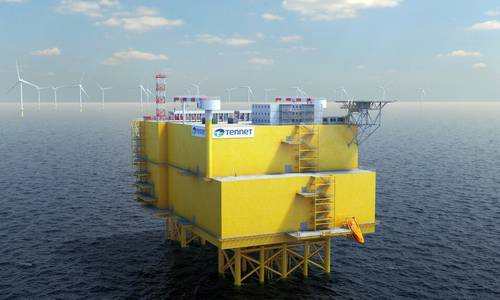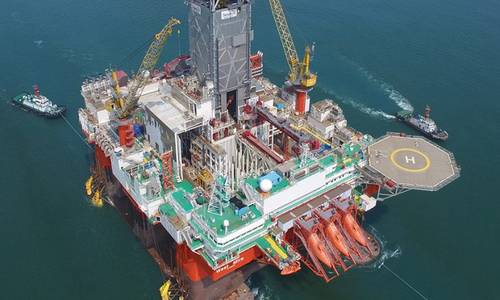History Repeats Itself: Energy, Borders and the War Narrative in the Americas
by Wilfred De Gannes
October 31, 2025

Oil and gas have not only fueled economies but created rivalries, territorial disputes and wars. In the last one hundred years or so, since petroleum resources have been commercially extracted it is central to numerous armed conflicts.
Some notable examples, are seen in Europe, Middle East, Africa and now extending into the Southern Caribbean:
1. World War II (1939-1945)
German Expansion: One of Hitler’s strategic goals was to access oil in the Caucasus (Baku, Gronzny and Mailok areas). The 1942 Battle of Stalingrad was directly tied to Germany’s push toward the enormous Soviet oil fields.
2. Middle East Conflicts
- Iran (1953 Coup): The nationalization of the Anglo-Iranian Oil Company (now bP) by Prime Minister Mossadegh led to a United States-United Kingdom backed coup, reinstating the Shah. While not a direct war, it set the stage for decades of instability.
- Gulf War (1990-1991): Iraq’s invasion of Kuwait was triggered by Kuwaiti overproduction which had the direct effect of keeping oil prices low and alleged directional drilling into Iraqi oil fields. The U.S.-led coalition intervened to secure Gulf oil supplies, whereby major U.S. Oil and Gas corporations such KBR (NYSE: KBR) was heavily involved in providing wide ranging post-war engineering, maintenance and construction services to Iraq’s oil and gas sector, leading the development of the Majnoon Oil Field and Front-End Engineering Design (FEED) for a fertilizer plant.
3. Africa
- Niger Delta Region (Nigeria): Since the 1990’s, conflicts between the government, multinational oil companies, like Shell Nigeria, and militant groups such as the Movement of the Survival of the Ogoni People (MOSOP) have resulted in pipeline sabotage, kidnapping and armed conflicts over wealth distribution.
- Sudan (1980-2000s): Oil discovered in southern Sudan intensified civil wars, where control of oil fields became a major driver of conflict, eventually resulting in South Sudan declaring independence in 2011.
4. Russia-Ukraine War (2022 – present):
- While more about geopolitics and security, and control over natural gas transit routes to Europe factored into tensions. By 2020, Ukraine transited more natural gas than any other country in the world as it remained the main route for Russian natural gas sold to Europe, earning Ukraine about USD$3 billion per year in transit fees, before the launch of the Nord Stream pipeline, which bypassed Ukraine.
The Russian-Ukraine gas disputes caused a significant fall-off in supplies to the European Union. This alongside coincidental attempts by Ukraine to monetize it huge natural gas resources in the Donbas region since 2014 and now occupied by Russian as a means of controlling the supply side of European energy equation. Russia’s share of EU imports of pipeline gas dropped from over 40% in 2021 to about 11% in 2024.
Guyana’s Essequibo: Prosperity for Some, Provocation for Others
The ongoing Essequibo dispute with the Bolivarian Republic of Venezuela is one of today’s clearest examples of how oil and gas can intensify long-standing territorial conflicts. Venezuela claims about two-thirds of Guyana’s land area, known as the Essequibo region which is made up of around 160,000 kilometers square. It argues that the 1899 arbitral award giving Britain (then-colonial ruler of Guyana) the territory was invalid. When Guyana gained its Independence in 1966, Venezuela renewed its claim. The Geneva Agreement that same year left the issue unresolved, with the United Nations later becoming involved.
Exxon Mobil’s Offshore Discoveries Put Guyana Center Stage
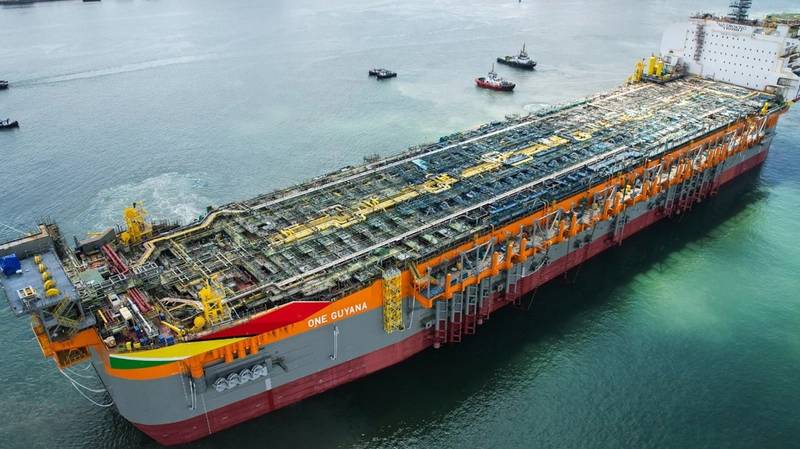
SBM Offshore constructed and installed the ONE GUYANA FPSO for ExxonMobil’s Yellowtail field, the fourth and largest project in the Stabroek block (Credit: SBM Offshore)
With the recently concluded elections held in September resulting in the incumbent government led by Dr. Mohamed Irfaan Ali being democratically voted to serve another five-year term, ExxonMobil Guyana Limited (EMGL) could soon receive approval for its eighth Ultra Deep-water oil and gas development in the Stabroek Block, known as the Longtail project, following review of EMGL Field Development Pan (FDP) by the Petroleum Department of the Ministry of Natural Resources. This alongside the simultaneous review of their Environmental Impact Assessment (EIA) by the Georgetown headquartered Environmental Protection Agency.
As of August 2025, over 8,900 persons are employed directly and through contractors, and Guyana’s offshore infrastructure comprised of some four (4) operational Floating Production Storage Offloading ships (FPSOs) named LIZA DESTINY, LIZA UNITY, PROSPERITY and ONE GUYANA with a fifth, the JAGUAR currently under construction at the Seatrium yard in Singapore by SBM Offshore (AMS: SBMO). With a design name plate capacity to handle crude production at a rate of 250,000 barrels per day (b/d) JAGUAR is expected to be permanently moored about 200 kilometers offshore Guyana. This design is based on its Fast4Ward program and reinforces SBM Offshore “commitment to standardize efficient and sustainable offshore productions solutions.”
Trinidad & Tobago Joins the Ultra Deepwater Race
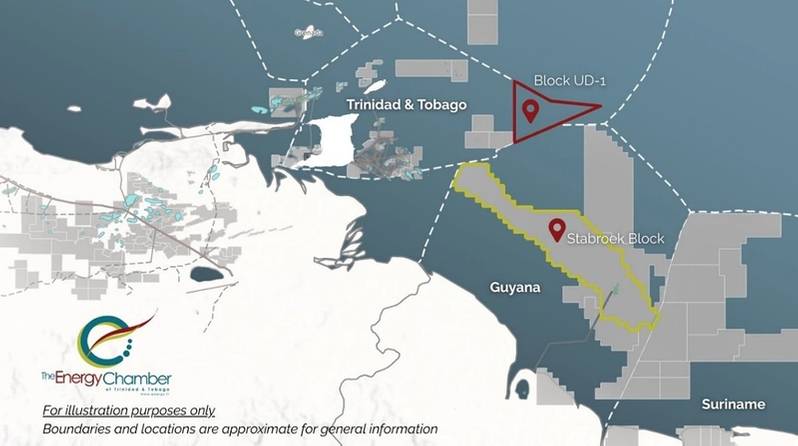
Map showing Trinidad and Tobago’s UD-1 block where ExxonMobil could invest US$21.7 Billion next door to their prolific Stabroek block in Guyana waters (Map Courtesy: The Energy Chamber of T&T)
These immense offshores discoveries found in the prolific Cretaceous-aged formations in Guyana, and nearby Suriname estimated to be larger than the entire Gulf of Mexico (renamed by U.S. authorities in 2025 as the Gulf of America) can easily mirror into cross-border success in the adjacent 7,165 square kilometers Ultra Deep-1 (TTUD-1) block. The no-bid Production Sharing Contract (PSC) for the ultra-deepwater exploration block was signed between The Honorable Prime Minister Kamla Persad-Bissessar, S.C., M.P., and ExxonMobil (NYSE: XOM) Vice President of Global Exploration John Ardill at the Diplomatic Center in Port of Spain, on August 12, 2025.
During a follow-up meeting, ExxonMobil Trinidad and Tobago operations manager Dr. Bram Willemsen said the block’s operations for the next six (6) months remain on track, including permit applications, and geological and geophysical work required for conducting the 3D seismic survey in 2026. Once surveys look favorable the venture would utilize advancements in offshore deepwater drilling technology, including innovations in drill ships and high-pressure, high temperature systems, making the 2,000 to 3,000 meters ultra deep-water acreage viable.
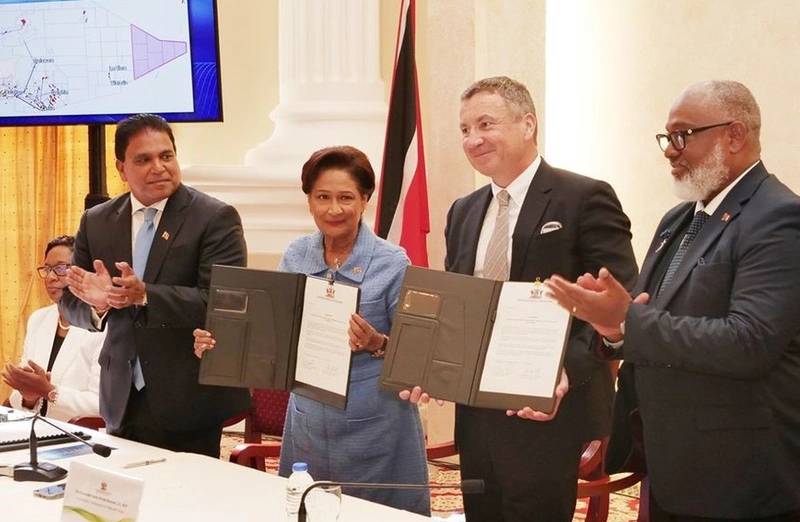 [R to L]: Minister in the Ministry of Energy and Energy Industries, Hon. Ernesto Kesar, M.P. alongside ExxonMobil V.P. John Ardill, with The Hon. Prime Minister of Trinidad and Tobago Kamla Persad-Bissessar, S.C., M.P., and Minister of Energy Hon. Roodal Moonilal, M.P. (Credit: Ministry of Energy & Energy Industries, GoRTT)
[R to L]: Minister in the Ministry of Energy and Energy Industries, Hon. Ernesto Kesar, M.P. alongside ExxonMobil V.P. John Ardill, with The Hon. Prime Minister of Trinidad and Tobago Kamla Persad-Bissessar, S.C., M.P., and Minister of Energy Hon. Roodal Moonilal, M.P. (Credit: Ministry of Energy & Energy Industries, GoRTT)
The recent internal corporate restructuring of the Atlantic LNG plant, located on Trinidad’s South-western peninsula now allows for additional natural gas throughput by non-shareholding entities thereby setting the stage from ExxonMobil to possibly become major a gas supplier for the three (3) operational LNG trains at Point Fortin, alongside BP PLC (NYSE: BP), and Shell PLC (NYSE: SHEL) who are currently the largest shareholders.
CARICOM
Prime Minister Kamla Persad-Bissessar has also reiterated more than once “Should Venezuela invade Guyana, Trinidad and Tobago would definitely step forward to defend of our cousins, brothers and sisters in CARICOM.”
Trinidad and Tobago and the Republic of Guyana being founding member states of the Caribbean Community (CARICOM), an intergovernmental organization that serves as a political and economic union of fifteen (15) member states and five associated members throughout the Americas, the Caribbean and Atlantic Ocean. Headquartered in Georgetown, Guyana, CARICOM plays a central role in regional integration and cooperation. It is also noteworthy to mention that the U.S. Virgin Islands, located in the central Caribbean region have initiated steps for eventual associate membership in March 2024.
Supplying but not Belonging: Venezuela’s Caribbean Energy Role
From the long ongoing territorial dispute and Guyana’s Independence in 1966, it is not difficult to understand why the Bolivarian Republic of Venezuela was never accepted to be a CARICOM member, despite its 1,700 miles of coastline along the Caribbean Sea and Atlantic Ocean. Venezuela through its Petróleos de Venezuela, S.A. (PDVSA) has long supplied petroleum products to smaller Caribbean island-states like St. Vincent and the Grenadines and Jamaica through its PETROCARIBE agreement, established in June 2005.
This flagship initiative by the late popularist President Hugo Rafael Chávez Frías provided discounted oil and preferential payment terms to seventeen (17) Caribbean and Central American nations, allowing them to pay up to 25-years at a low interest rate, with flexibility to also settle through goods and services.
Gunboat Diplomacy Returns: Energy and the Risk of Conflict
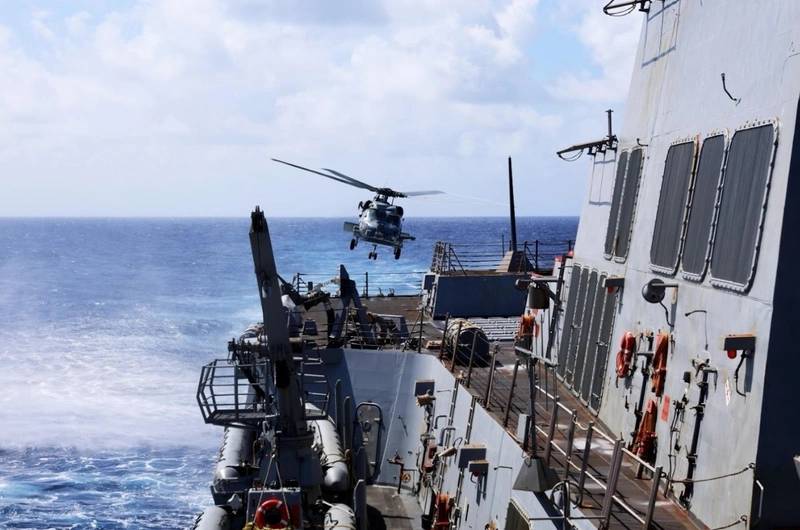 USS GRAVELY (DDG-107) is an Arleigh Burke-class (Flight IIA) Aegis missile destroyer. One of seven U.S. Navy ships now patrolling waters between Trinidad and Tobago, Guyana and Venezuela. (Credit: U.S. Navy photo by Mass Communication Specialist 1st Class Ryan Williams)
USS GRAVELY (DDG-107) is an Arleigh Burke-class (Flight IIA) Aegis missile destroyer. One of seven U.S. Navy ships now patrolling waters between Trinidad and Tobago, Guyana and Venezuela. (Credit: U.S. Navy photo by Mass Communication Specialist 1st Class Ryan Williams)
Southern Caribbean energy production is at the heart of a growing geopolitical storm. Guyana’s offshore oil boom already surpassing 900,000 b/d with ExxonMobil’s ONE GUYANA Floating Production Storage Offloading ship. Overall total output is projected to reach 1.7 million b/d by 2030 has reshaped the regional energy landscape. This rapid rise has made Guyana one of the world’s fastest-growing oil exporters, drawing in massive foreign investment while simultaneously escalating tensions with Venezuela, which claims sovereignty over the Essequibo region and its adjoining waters. Offshore production ships, sub-sea umbilical pipelines and maritime shipping lanes have become strategic assets and potential targets in a dispute that risks destabilizing the Caribbean.
For Trinidad and Tobago the stakes are equally pressing, where its 117-years energy sector comprises eighty percent (80%) of export revenues in fiscal 2023/24 and is now more than ever heavily reliant on offshore gas, as several locally-based Methanol, Ammonia and the 15 million metric tonnes per annum (tpa) LNG trains have been consistently running below their engineered capacity. Projects near the Venezuelan maritime border such as the Dragon and Cocuina-Manakin offshore gas fields represent critical opportunities to stabilize declining output, but are vulnerable to current diplomatic rifts.
In this climate, the presence of U.S. Navy warships in the southern Caribbean are increasingly regarded as vital for de-escalating regional tensions, deterring military posturing, and safeguarding critical ultra-deepwater oil and gas infrastructure. Without such stabilizing measures, the region known as a ‘Zone of Peace’ by CARICOM members risks seeing its energy lifelines transformed in flashpoints of conflict, undermining both regional economies and global oil and gas security.
Forging Strong Bilateral Ties: Trinidad and Tobago and the United States
The United States Department of State’s Bureau of Overseas Building Operations (OBO), in partnership with the U.S. embassy in Trinidad and Tobago, has just announced the start of construction on the new US$400 million embassy in Port of Spain. Set on an 11-acre site acquired in 2023, this facility is expected to be one of the largest and most secure U.S. diplomatic compounds in the Western Hemisphere. This significant investment underscores Washington’s commitment to its diplomatic and security relationship with its key Caribbean trading partner, while also creating employment opportunities for hundreds of Trinidad and Tobago nationals throughout the construction phase.
The longstanding relationship between the United States of America and Trinidad and Tobago has always been of strategic importance and cultural exchange. During World War II, Trinidad served as a critical location for U.S. naval and air bases, laying the foundation for enduring ties. Today, those connections remain strong and visible from shared diplomatic and economic interest to cultural expressions abroad. A striking example is the annual presence of Trinidad and Tobago’s top steel bands performing under the under the bright lights in the center of Times Square, New York City – an enduring reminder of how the islands’ music continues to resonate on the global stage.
The legacy of this cultural innovation is rooted in the oil industry. Between 1956 and 1985, the TEXACO refinery at Point-a-Pierre played an unlikely role in shaping Trinidad and Tobago’s musical identity. The reuse of 55-gallon oil drums from the refinery provided the foundation for the widespread development of finely tuned steelpans, as instrument now celebrated worldwide as the national instrument of Trinidad and Tobago. That journey came full circle earlier this year when Harvard University officially welcomed the Harvard College Steelpan Ensemble, an achievement made possible by the dedication of Trinidadian student Adam Bartholomew. What began as recycled oil drums has evolved into a global symbol of cultural pride and academic recognition.
 Reuse of 55-gallon oil drums utilized to make musical steel band instruments. Photo (Credit: Adam Bartholomew)
Reuse of 55-gallon oil drums utilized to make musical steel band instruments. Photo (Credit: Adam Bartholomew)
Explore the latest edition of Offshore Engineer Magazine which features the piece 'History Repeats Itself: Energy, Borders and the War Narrative in the Americas' by Wilfred de Gannes, and many more provided by leading industry experts and journalists.

